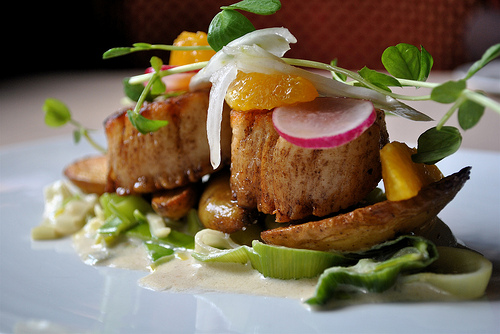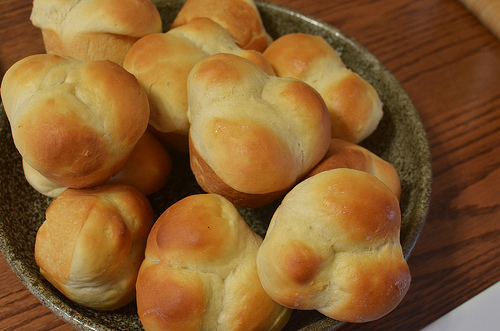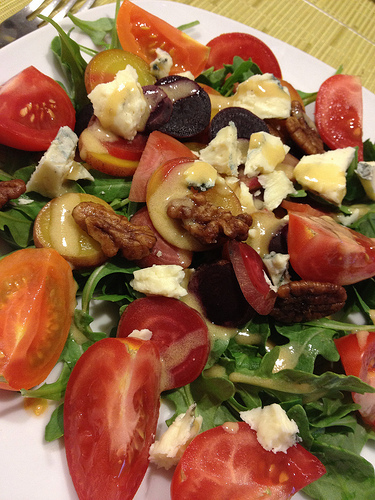How do you calculate catering per person? It’s one of the most common questions our restaurant marketing consulting business gets. The answer is actually pretty straightforward, but that’s easily said when you have decades of experience! So with that said, let’s dig into how to calculate food portions for catering!
How do you calculate catering per person?
The way you calculate catering per person boils down to whether you calculate each catering portion by piece, weight, or volume for your main dishes, side dishes, desserts, and bread of course. Also, you want to add a 10% buffer to this so you don’t run out.
When you are first starting out, knowing how to calculate catering quantities per person in these different ways is crucial because:
- You don’t want to run out of food
- You want to budget so as to make money on the event
Let’s look at how to turn this process into a science instead of an art form. These general guides will help you calculate your food quantities for 95% of your events.
When you are first starting out, knowing how to calculate food quantities for catering is crucial. One, you don’t want to run out of food and two, you want to make money on the event.
I hope this post will teach how to turn this process into a science instead of an art form. These general guides will help you calculate your food quantities for 95% of your events.
Catering serving sizes by food type
Let’s look at how to determine catering serving portions for each attendee by the types of food, and also taking into consideration the methods of serving.
Entrée (meat)

Entrees by the piece
Entrees are usually the stars of the show at catering events. For this reason, the amount of food served is incredibly important. Always keep in mind that we really do not want to run out as this will upset your guests.
Especially at events with carving stations or specialty items. However, as I mentioned above, you still need to make some money.
By the piece
It is much easier to calculate how much food to bring when you are dealing with entrees that are just pieces of meat (chicken, fish, pork, steaks, etc.) Simply add a cushion to your headcount like 5-10%.
You might want to also add a few extra portions for your staff to eat if it will be a longer event.
Let’s say you have a 100 person event and are serving grilled chicken breast. If this is going to be a self-service buffet, you may want to add the 10% buffer (110 chicken breasts) since a number of guests may take two or come back for seconds and you can’t really control that.
If this is a plated meal then you should feel comfortable bringing only 105 chicken breasts (5% buffer) this gives you just a few extra pieces in case an accident happens (plate drops, entrée drops, etc.)
Be sure to communicate this clearly with your client. Let them know you only prepare food for 5-10% over their head count so if they are expecting 110 they need to order for 110 not 100 and hope the food will last.
Also let them know you are pricing out for 1 piece per person, if they want extra like 1.2 or 1.5 pieces per person then simply charge them a little extra for it!
When you are calculating food cost on your menu items, be sure to include this 5-10% buffer so you are getting paid for it!
By weight

For entrees that you have to serve by weight (casseroles, lasagna, shredded or sliced meats) we like to use a 4 oz. portion for lunch and a 6 oz. portion for dinner.
So going back to our 100 person example, let’s say you opt for the 10 % buffer, simply multiply 110 x 6 oz. = 660 oz. total. 660 oz. / 16 oz. per pound = 41.25 pounds for dinner.
Or 110 x 4 oz. = 440 oz. total. 660 oz. / 16 oz. per pound = 27.5 pounds for dinner.
Try these for a few events and see how it goes. If you are finding the 4 oz. portion is running to close then bump it up to 5 oz. or vice versa for the dinner portion.
Sides
Sides can be tricky and as you start catering more events you will better be able to calculate catering serving sizes according to guest count.
One of our most popular side dishes is a potato casserole that we know we can only serve 30 people per full pan while almost every other side dish we can serve 50 like clockwork. People come up for seconds and take huge spoonfuls. So if you know you have something that is going to be popular go heavy.
You can calculate portions two ways for sides, by weight or by volume. Most of the time you will probably want to calculate this by weight.
However, sometimes you will be selling side dishes by the gallon (for us it is items like BBQ beans, mac and cheese, potato salad, etc.)
By volume
For these items, you should be able to get 25-30 portions per gallon which is a 4-5 oz. portion. As your events get larger (over 200 people) or they have multiple sides these numbers start to spread to 40-50 people per gallon.
For example, when we perform large BBQ catering, we know everyone will get mac and cheese but most people will choose either beans or coleslaw. So we still bring one gallon of mac for every 25 people but only bring one gallon of beans/coleslaw for every 40-50 guests.
By weight
For potatoes and pasta, we like to bring one pound for every 4 guests (1/4 pound per person). For rice, we use ¼ cup of dry rice per serving. For vegetables, you can easily get away with 1 pound for every 5 guests (~3 oz. portion).
You should also still use the 5-10% buffer for these sides as well. This will ensure you have plenty for your event.
Salads
Salads can be tricky in catering events. You will have some events where they won’t touch it and the next day go on an event the same size with the same quantity and run out.
Plated meals are definitely the easiest way to prepare salads. Usually, guests aren’t expecting huge salads.
By weight
We tend to get about 40 salads out of a 3 lb. bag of spring mix. Which is about 1.5 oz. of spring mix per salad. By the time you dress it and add your toppings it turns into a 4 oz. salad which is fine (unless you serving a dinner salad!)
By volume
For buffets, we like to estimate 35-50 guests per full pan of salad. I know this is a pretty big range but like I said, salads can be tricky.
9 times out of 10 if you brought two really full pans of salad for 100 people you should be fine.
However, one little trick we learned, if you start flying through the salad (or any item for that matter) don’t refill the buffet line until you are absolutely out. People tend to grab less as they see the items are running out.
If you wanted to take it one step further just refill half of the pan from your backup and let that run out of again. This should at least give you enough breathing room to make it last to the end.
Bread

Bread serving portions for catering is pretty straightforward. For full-service buffets, we like to bring 1.5 pieces of bread per guest. This has served us well because some guests won’t take any bread and some will take 2 (or more!).
For plated meal events, you can probably just use your regular 5-10% buffer since you will be making the plates for the guests. If your rolls are small then you might still want to have some extras as some guests may request more.
Final points on how to order catering food quantities per person
After reading this post I hope you feel more comfortable calculating food quantities for catering events. Remember, these are general guidelines that should be pretty good for most events.
However, you will still need to know your customers. For example, if you land a catering event where you are serving a college football team, well you better be prepared for them to eat some food! You can charge for that as well.
Or maybe you are serving a group of elementary school teachers you could probably get away with going a little light on your portions.
Don’t try to get too greedy though, because you don’t want to run out of food. That reputation is hard to break! It also makes it hard for your staff as you start delegating some of these roles.
You don’t want to be the only one to plan every event. Create catering formulas and stick to them, your staff will appreciate them.
Catering portions calculations made easy
How do you calculate catering per person in your business now? If you’re doing it manually, or you’re guessing, this is where I can make life easier for you.
Enter your email address below and I’ll send you a catering calculator free of charge that will make catering quantity orders easy!




what an interesting and detailed post! My husband and I used to own a restaurant in Germany (before Germany joined the Euro – which hit restaurants hard! ), but we never ventured into catering. Still, I found this a very useful post, and shared it with everyone on social media. Blessings!
Thank you for sharing Claudia! Catering is a great way to add revenue to your restaurant.
Hi Chris,
I’ve been to some social functions and a couple times the catering company ran out of meats. I’m sure they didn’t use or apply your formulas. The way you broke down the situations and explained how to prepare for the events is simple and easy to follow. If I ever plan a big party I’ll make sure to use these suggestions you’ve shared. Thanks for the great information!
Thanks Jon, I’m sure the guests were not please at those events where they ran out of meats. Especially in our market, that is a big no no!
Although I am not in the restaurant trade, I do struggle with quantities when cooking for my small family. I usually put on too much food, but I don’t mind as what is leftover can be had the next day. Although this happens far too often. This was a great post as it will help me serve up the correct amount of food. Thank you.
You’re welcome Owain, I’m glad you were able to learn about food quantities from the post!
I like that you use a 5% rule in order to make sure you have just a little bit extra. I could certainly see how people my eat extra when it comes to a buffet. I think this would work for parties as well. Thanks for the valuable tips.
Thanks Wendy, having that little bit extra goes a long way with the customer. Think of it as marketing!